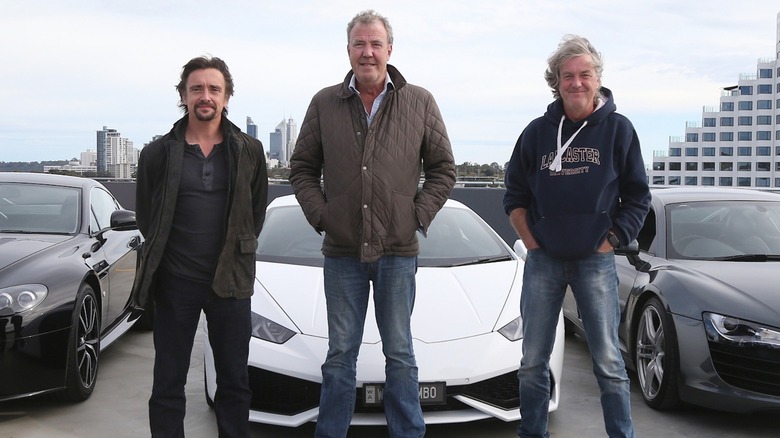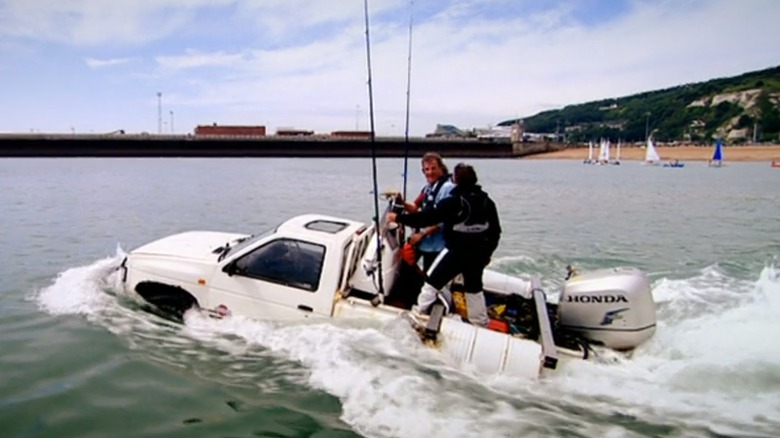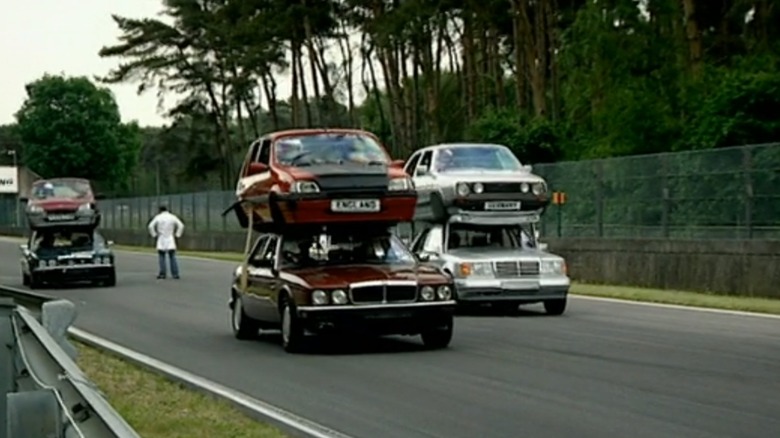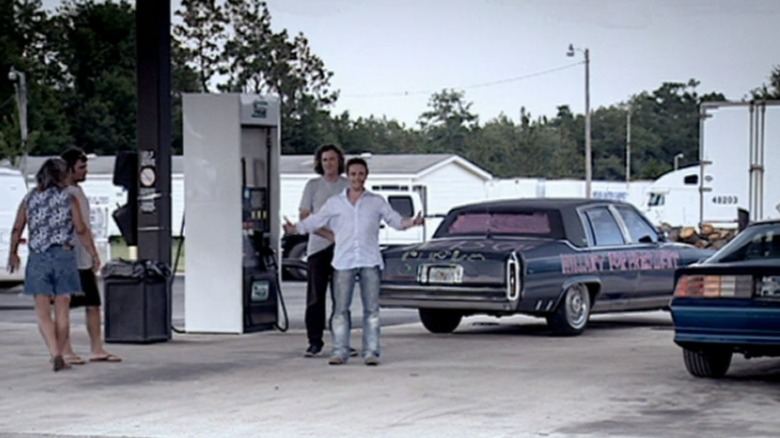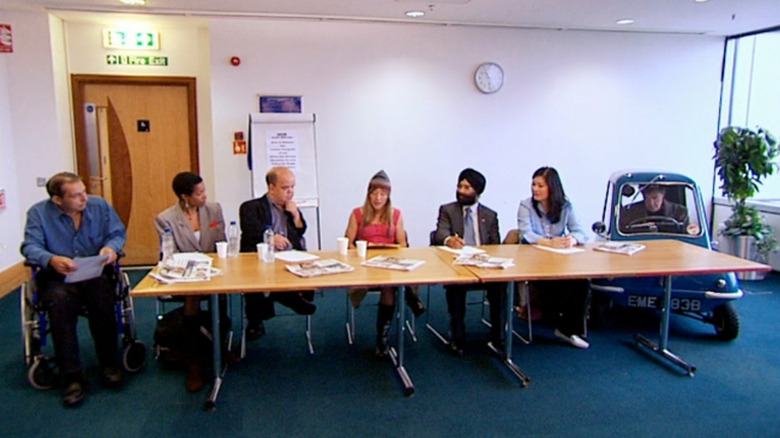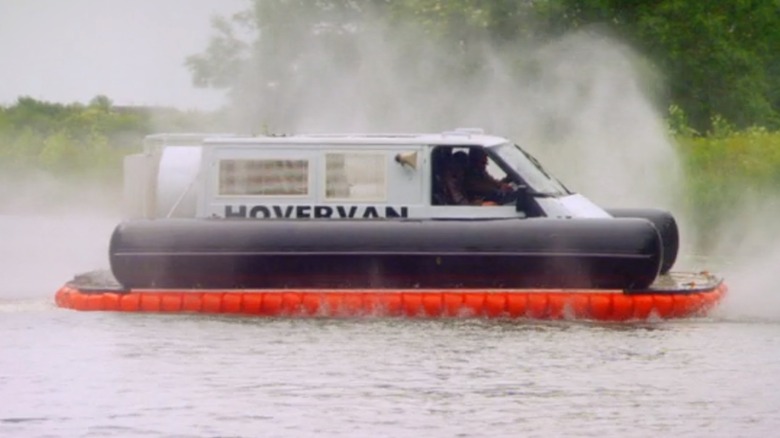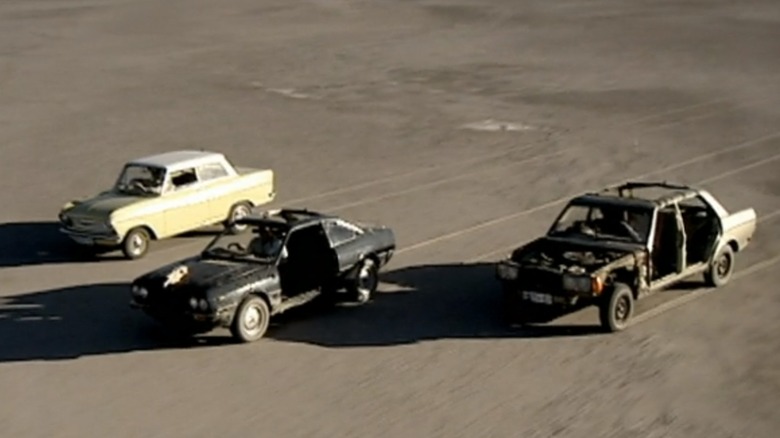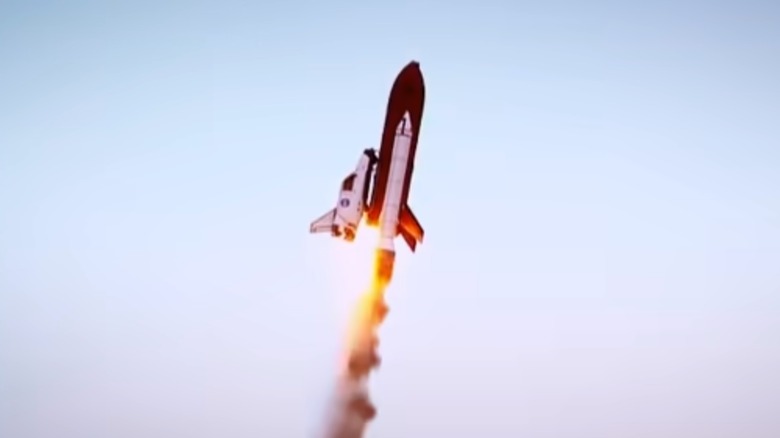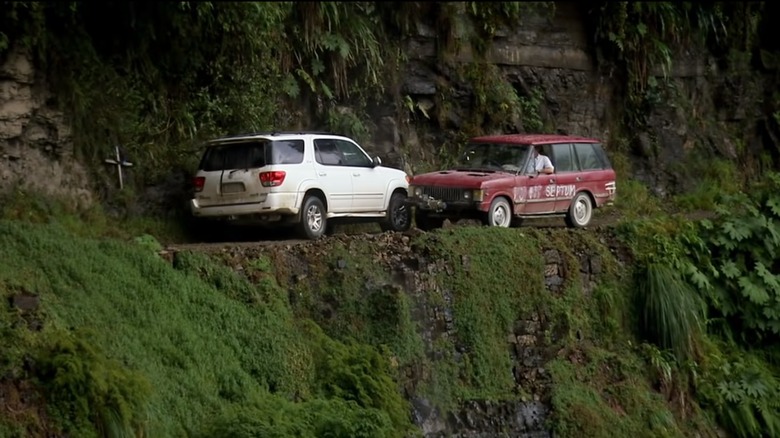Top Gear's 10 Most Memorable Stunts You Have To See
Debuting in April of 1977, the BBC motoring show "Top Gear" has been through many changes in format, substance, and personnel. For a couple of decades, it was a straightforward show about cars and the automotive industry at large, gaining widespread popularity throughout the U.K. Jeremy Clarkson joined the show in 1988, staying until 1999, and the show would ultimately be canceled in 2001 after a decline in viewership. But in 2002, Clarkson joined co-producer Andy Wilman to pitch a revival of the show, which was greenlit and reappeared in 2002. And that is when the show really got interesting.
The new show returned with presenters Jeremy Clarkson, Richard Hammond, and Jason Dawe, who was replaced after one season with James May. This is the format that took off thanks to the chemistry of the three presenters and their producer, Wilman. The new show was a hit, entertaining petrolheads and commoners alike with their antics, playful insults, and staged theatrics. It went on to run for many seasons, spawning foreign editions in countries such as the United States, South Korea, Italy, and France.
It seemed to be an unstoppable juggernaut until an incident during filming in 2015 led to Clarkson being fired, with Hammond, May, and Wilman leaving with him. The show has continued to air since then with other presenters, including Matt LeBlanc of the hit show "Friends." But the revival of the show, running from 2002 to 2015, featured the most watched episodes with the most notorious bits that fans love. And it's this period we're looking at for the 10 most memorable stunts you just have to see — if you haven't already.
Amphibious car challenge
Beginning in a segment in season 8, episode 3, and finishing in season 10, episode 2, the presenters are challenged with buying an ordinary used car and transforming it into an amphibious vehicle. True to form, the trio picks up specimens of dubious quality and sets out to alter them in typical haphazard and often ill-conceived ways. Throughout the show, they take their newly aquatic cars through a variety of tests, culminating in an attempt to cross the English Channel.
Jeremy Clarkson chose the venerable and nearly indestructible Toyota Hilux pickup, waterproofing it by welding a hull to the underside and affixing a Honda outboard motor to the tailgate. James May chose a Triumph Herald and transformed it into a sailboat, while Hammond added some boat-like bits to a Volkswagen Vanagon, using the rear-mounted engine to directly drive a propeller out of the rear.
The first few challenges of the show prove to be, well, challenging. Clarkson and Hammond's contractions sink in a lake, while May's ended up with no clutch, though he managed to avoid sinking. The final challenge, in which Hammond and Clarkson have replacement vehicles with "improved" modifications, takes place at Dover, where the trio is tasked with sailing across the English Channel in these obviously dangerous and unseaworthy vessels. Again, two of them sink in short duration, leaving all three to board Clarkson's minitruck ferry for France. The show ends with them triumphantly landing at Calais.
This went on to be one of their more memorable episodes. The series of trials and tribulations of building and sailing these questionable boats makes for genuinely funny entertainment, even if the final accomplishment, crossing the channel, was more than likely just staged for the camera.
Double-decker racing
Season 11, episode 6 presents us with a challenge that has been played out at least a couple of times before, a battle between Englishmen and Germans. Although the "Top Gear" crew arrived in Germany in three Supermarine Spitfire fighter planes, this rivalry was of a friendly nature. This exhibition pitted the "Top Gear" crew against a trio of presenters from a German motoring show called D Motor.
The rivalry would be played out in a race created in Germany that includes an interesting twist: Double-decker cars. This means each team must race a car set up such that one driver operates the accelerator and brake while their teammate steers from another car attached to the roof, leading to some rather amusing moments.
The insanity of racing like this is hard to describe. It looks hilariously fun as well as a little dangerous. The handling and tendency to topple over from having an entire car on the roof looms large. And if that is not enough of a handicap alone, communication from the engine controls to the steering controls is near impossible. The race is more of a spectacle than a genuine competition. In the end — spoiler alert — the Germans won.
Pressing their luck in Alabama
After a few years, "Top Gear" started producing hour-long specials. In season 9, episode 3, they embark upon travels across the South after being given $1,000 to buy cars in Florida. Jeremy Clarkson bought a Camaro, James May found a giant Cadillac, and Richard Hammond bought, of course, a Dodge pickup.
They received a challenge to drive through Alabama without getting shot or arrested, with bonus points for getting one another shot or arrested by "decorating" each others' cars with choice slogans antithetical to this "Bible-bashing, redneck, deeply Christian" part of the country. This resulted in the slogans: "Hillary for president," "Man love rules," "and "Country and western is rubbish," among others.
At one point, a fuel station owner asks, "Are y'all gay looking to see how long it takes to get beat up in a hick town?" Despite Clarkson attempting to reassure her he is, indeed, married with children, she remains unimpressed and says she is going to "get the boys." At this very perfect moment, May's Cadillac would not start and needed a jump from Hammond while a truck carrying large men with shotguns pulled in. These guys start throwing rocks at the film crew, pelting the van. Clarkson takes off, followed shortly after by Hammond and May. Video recording ended, and only audio was captured during their getaway, followed by a cell phone video of them removing the offending slogans.
While most of the "Top Gear" hijinx are carefully scripted and staged to some degree, this was not. Hammond has since said in interviews that it was the scariest moment ever recording the show and a very real scene.
World's smallest car at the office
If you were unaware of what the smallest production car ever built was, that would be the Peel P50 built on the Isle of Man in the '60s. It is a tiny fiberglass box with three wheels powered by a 49cc scooter engine. It is so small the reverse is just a handle on the rear used to simply pull it out of a parking space.
Jeremy Clarkson does a half-hearted review of this car in the third episode of series 10, taking it up to the BBC offices, arriving on his floor by taking the car up in the elevator. While making a phone call, an executive is then seen driving it through the office, with Jeremy following him a few moments later to retrieve his tiny auto. A short drive through London to the buildings of the BBC production offices finds him once again driving through an office complex, including a cutaway to a BBC news presentation in which the car can be seen driving in the background. This visit ends with Clarkson attending a meeting about climate change, seated in the car.
This review is more about making jokes than offering useful information. It is also not the wildest or most extreme of the many stunts found on the show, but it might be just as entertaining. It certainly is relatable, as many, if not most, of us, would jump at the chance to drive a tiny car to work all the way to our office.
Canal bound hovervan
Flooding is a serious problem for people in many parts of the world. The U.K. is not immune, and in 2013, flooding occurred in the country, causing tremendous hardship. Expressing their deep empathy for flood victims and definitely not using the catastrophe as an excuse for a silly stunt, Jeremy Clarkson, Richard Hammond, and James May set out to create something that could help those affected by flooding.
Ever the bold inventors and engineering geniuses, the trio devise a plan to create a hovercraft capable of traversing land and water to reach those stranded by floods. A hovercraft was chosen for its unique amphibious qualities that would enable them to get to flood victims and whisk them away to dry land and safety. However, it was decided that a typical consumer-grade hovercraft would be inadequate because of a lack of cargo space to carry supplies and victims. But they had a solution.
To provide enough room, they picked up a Ford Transit van, setting out to make it glide across land and sea. The van's front-wheel drive allowed it to move effortlessly on pavement, and, somehow, the engine was connected to a fan used to fill the skirt so it could hover. The remaining power needed for forward propulsion via a large fan came from an additional engine installed inside. The resulting contraption worked poorly as a van and not much better as a hovercraft, although, with credit to the builders, it did not sink. Of course, a trip down the river Avon displayed some inherent weaknesses, mostly contributed to the operator, Clarkson.
Makgadikgadi Pan desert run
Season 10 of the show saw the trio headed to Africa for their Botswana special. This episode is full of adventure as the crew traverses the wilds of Africa on primitive roads far from a convenience parts store should anything break. And something always breaks. They must first buy a car for £1,500 and drive it 1,000 miles to the Namibian border. Jeremy Clarkson shows up with a cool but questionable Lancia Beta Coupe, while James May purchases a sensible and notoriously indestructible Mercedes 230E. Richard Hammond finds an Opel Kadett in near pristine condition.
They are presented with a challenge to cross the Makgadikgadi Pan, an ancient lake bed that dried up tens of thousands of years ago, leaving behind a giant salt flat. To prevent sinking into the surface, weight shedding was needed to cross successfully. However, having grown attached to his Opel, which he has named "Oliver," Hammond is unable to bring himself to remove anything. Before setting off, they receive a visit from the Vice President of Botswana, who arrives via powered parachute. He is also dubious of their ability to make it across in those cars.
Shortly into the journey, May's heavy Mercedes starts sinking into the ooze, signifying the weight savings were not enough. He gets stuck. Clarkson runs into similar problems. But, amazingly, Hammond's lightweight Opel experiences no difficulty whatsoever. Clarkson and May had to remove even more weight, shedding doors, seats, and windows. And while they continued sinking into the ground, Oliver hummed along perfectly. However, despite these trials, all three of them made it across without being relegated to the Beetle, the backup vehicle.
Reliant Robin Space Shuttle
While the three-wheeled Reliant Robin is mercilessly lambasted repeatedly on "Top Gear," during season 9, episode 4, Richard Hammond and James May try to make one into a vessel with another purpose: space travel. Hammond begins with a brief drive and overview of the car before he teams up with May to recruit some professional guidance.
The guys go to the British Amateur Rocket Society for some help in engineering a rocket to strap on a Robin in the same manner as the Space Shuttle. While the booster rocket is constructed, some wind tunnel testing of a scale model of a rocket with a Robin attached demonstrates the inherent qualities of the Robin that make it poorly suited to launch. Furthermore, a scale model mocked up by an R/C airplane club shows that, as a plane or a glider, even well-engineered wings cannot help with the aerodynamics of the dowdy car.
Armed with a real Robin modified for a flight down to Earth, they prepare for what would be the largest non-commercial rocket launch in Europe to date. The Robin is launched from a field in rural Britain, breaking free from Earth's gravity thanks to a magnificent plume of rocket-fueled thrust coming out of the main rockets. Then as the complete unit hits its apogee, where the Robin is set to release and glide back down to Earth, nothing happens. The experiment ends as it all falls back to Earth, ending the stunt in a fiery blast.
Tackling Bolivia's Death Road
In another special during season 14, this time in Bolivia, the guys must complete a few challenges in a variety of off-road vehicles bought with a maximum £3,500 budget. This sees James May in a Suzuki Samurai, Jeremy Clarkson in a Land Rover, and Richard Hammond in a venerable classic Toyota Land Cruiser, but all of these vehicles are aging. While all three of these vehicles are capable off-road, they excel in different terrains and purposes. After putting them through some tortuous challenges, including river crossings, they must drive these aging and somewhat decrepit vehicles on Bolivia's North Yunga Road, once named the most dangerous in the world.
High in the Andes, the Yungas road ascends to 15,000 feet, forcing travelers to navigate myriad switchbacks next to sheer cliffs on dirt and gravel that can change from one day to the next due to abundant rainfall. In some of its narrowest passes, only a single vehicle can pass. The "Top Gear" crew tackled this road for its 2009 special using their well-abused off-roaders. It looks truly perilous; passing cars on narrow lanes with no guardrails is terrifying. At one point, despite being warned well in advance, Clarkson is nearly murdered by May for having bumped his car, as is so often done as a joke.
Exceptionally, nobody fell into a ravine, and they did complete the journey. It makes for good entertaining television programming and makes you shudder to think that people have been taking this route since 1930. Today there is a modern road that bypasses this route. The high number of people who have died on this road prompted the government to finally find an alternative. It is also interesting to note that Yunga Road was closed to automobiles in 2006, remaining a cycling destination ever since. With the "Top Gear" special released in 2009, it is likely that everything in the film, even the local drivers, was all part of a script.
